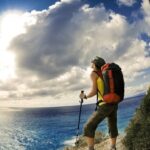Introduction
When traveling alone, it's important to make the most of every experience, and one of the best ways to do this is by engaging in outdoor activities. These activities offer a range of health and well-being benefits, as well as providing a unique way to explore nature as a solo traveler.
Outdoor activities are essential for those seeking a deeper connection with the natural world. They offer the opportunity to escape the hustle and bustle of urban life and reconnect with tranquility and beauty of nature. Furthermore, these activities provide a sense of freedom and adventure, allowing solo travelers to discover new places and experience different things.
Participating in outdoor activities also brings numerous benefits to physical and mental health. Studies show that spending time in nature can reduce stress, improve mood, and increase energy levels. Furthermore, exposure to sunlight during these activities helps with the production of vitamin D, which is essential for bone health.

One of the advantages of traveling alone and engaging in outdoor activities is the freedom to explore at your own pace. There's no need to worry about other people's interests or limitations. You can decide when and where to go, allowing you to focus on the experiences that interest you most.
Additionally, engaging in outdoor activities like hiking, biking, climbing, or canoeing gives you the opportunity to challenge yourself and push your limits. These activities require strength, endurance, and courage, and overcoming challenges during solo travel can bring a sense of accomplishment and self-confidence.
Trails and Walks
To the traveling alone, one of the most exciting and rewarding outdoor activities you can do is exploring trails and hiking. These activities offer a unique opportunity to connect with nature, push your limits, and discover stunning landscapes. However, before embarking on a trail adventure, it's important to consider a few key aspects to ensure a safe and enjoyable experience.
Choosing the right trail for your experience level
The first thing to consider when planning a hike is choosing a route that suits your experience level. There are trails for all levels, from beginners to the most experienced. It's recommended to start with shorter, easy trails, especially if you're a beginner. As you gain confidence and experience, you can venture onto more challenging trails. Researching trail information, such as distance, elevation, terrain, and weather conditions, is essential to making an informed decision.
Essential hiking gear
When preparing for a hike, it's crucial to have the right equipment to ensure your safety and comfort. Some essential items include:
- Suitable footwear: Choose comfortable shoes with good grip, such as hiking boots, to avoid slipping and injuries.
- Suitable clothing: Dress in layers to adapt to changing temperatures. Wear lightweight, breathable, and quick-drying clothing.
- Backpack: Bring a sturdy, adequately sized backpack to carry your belongings, such as water, food, sunscreen, a first aid kit, and other essentials.
- Navigation: Have a trail map, compass, and/or a reliable navigation device to help you orient yourself during your hike.
- Water and food: Bring enough water to stay hydrated throughout the trail. Pack energy-rich snacks and light meals to replenish your energy.
- Weather protection: Depending on the region's climate, bring a waterproof jacket, hat, gloves, and other items to protect against rain, wind, and sun.
Safety tips while hiking
In addition to the appropriate equipment, it is important to follow some safety tips during the trails:
- Inform someone: Always let a friend or family member know about the trail you intend to take and your estimated return time.
- Know your limits: Don't overexert yourself and respect your physical limits. Take breaks when necessary and listen to your body.
- Follow the signs: Observe and follow the trail signs to avoid getting lost or straying from the route.
- Respect nature: Stay on designated trails and don't disturb the local flora and fauna. Remember to take all your trash with you and leave the area as you found it.
- Weather conditions: Be aware of weather conditions and avoid dangerous trails in case of storms, heavy snow, or other adverse conditions.
Exploring stunning landscapes on foot
One of the main rewards of hiking and trekking is the opportunity to explore stunning landscapes on foot. Each trail offers an experience unique, with panoramic views, waterfalls, mountains, forests, and much more. During your hike, pay attention to all the details and curiosities around you. Observe the local flora and fauna, listen to the sounds of nature, and feel a deep connection with the natural environment. Enjoy every moment and take time to appreciate the beauty that nature has to offer.
Camping
To the traveling alone, one of the most rewarding outdoor activities is camping. Finding a quiet, secluded spot to pitch your tent and spend a night under the stars can bring a sense of peace and connection with nature that's hard to find elsewhere. However, before embarking on this adventure, it's important to be prepared and know some important details to ensure a safe and enjoyable experience.
Finding the ideal camping spot
Finding the perfect camping spot is essential for a positive experience. Research campgrounds near your destination and see if they offer the tranquility and amenities you need for your stay. It's also important to check whether you need permission or any fees to use the area.
When choosing a location, consider the proximity to water sources and the availability of restrooms or sanitary facilities. Also, make sure the location is safe and away from hazardous areas, such as steep slopes or flood-prone areas.
Types of camping equipment
Before heading out to camp, it's important to be well equipped. Invest in a quality tent that's weather-resistant and has enough space for you and your belongings. Also, have a sleeping bag suitable for the local temperatures, a flashlight or headlamp, a portable stove for cooking, and a comfortable backpack to carry your gear.
Other useful equipment includes sleeping pads, cooking utensils, a first aid kit, insect repellent, sunscreen, and maps of the area. Be prepared for different situations and weather conditions, taking into account the season and the location of your campsite.
Getting ready for a night outdoors
To make the most of your night outdoors, it's important to prepare properly. Set up your tent in advance, choosing a flat spot free of rocks or roots that could cause discomfort while sleeping. Be sure to secure the stakes securely and use the ropes correctly to ensure the tent's stability.
Also, bring appropriate clothing for the weather conditions, including extra layers to protect yourself from the cold at night. Having a flashlight or headlamp handy is essential for moving around the camp at night. Don't forget to properly store food to prevent unwanted animals from approaching.
Enjoying the calm and tranquility of solitary camping
One of the advantages of camping alone is the ability to enjoy the peace and quiet of nature without distractions. **Disconnect from the digital world** and take the opportunity to relax, read a book, gaze at the stars, or simply enjoy the sounds of nature.
Take the opportunity to **explore the campsite's surroundings** by taking short walks or hikes. Observe the local flora and fauna, take photographs, and enjoy a picnic outdoors. These moments of introspection and connection with nature can bring a sense of renewal and well-being.

Water Sports
Discovering the fun of water sports
Water sports are a great way to have fun and enjoy time outdoors. With the vast number of rivers, lakes, and beaches around the world, there's always an opportunity to explore and try different water activities during your vacation. solitary journeysFrom the adrenaline rush of surfing the waves to the tranquility of stand-up paddleboarding on a serene lake, there are options for all tastes and skill levels.
Watersports options for solo travelers
There are several water sports options for solo travelers to try. If you're looking for excitement and a challenge, surfing can be a great choice. Beaches famous for their waves, such as Pipeline in Hawaii or Jeffrey's Bay in South Africa, attract surfers from all over the world looking for adventure and fun. If you prefer something more relaxed, you can try stand-up paddleboarding or kayaking. These sports allow you to enjoy the beauty of nature while exercising and relaxing in the water.
Equipment needed for water sports
When practicing water sports, it's important to have the right equipment to ensure your safety and maximum fun. For surfing, you'll need a board suited to your skill level and wave conditions. For stand-up paddleboarding, you'll need a dedicated board, a paddle, and a safety leash. For kayaking, you'll need a kayak suited to the type of water you intend to paddle in, as well as a life jacket and paddles. It's always important to check that your equipment is in good condition and take a short lesson or consultation with an experienced instructor to learn the correct techniques for each sport.
Water safety and important precautions
Water safety is essential when practicing water sports. Some important precautions include:
- Always wear a life jacket, even if you are a good swimmer;
- Know the conditions of the place where you will practice the sport, such as currents and tides;
- Never practice water sports alone, especially in unfamiliar places;
- Respect the safety rules and priority of other practitioners;
- Be aware of weather conditions and avoid water sports during storms or in rough waters;
- Let someone know your plans and return times, especially if you're doing water sports in remote locations.
Remember that safety should always be your priority when practicing water sports. Respect your limits and be prepared for emergencies.
Birdwatching
The best destinations for birdwatching
Birdwatching is a fascinating activity that allows solo travelers to appreciate the beauty and diversity of birds in their natural habitat. There are several destinations around the world that are known as true birdwatchers' paradises. One of the best destinations is the Amazon, with its rich biodiversity and a wide variety of bird species, including macaws, toucans, and parrots. Another popular destination is the Andes region, where species such as the Andean condor and the giant hummingbird can be found. There are also destinations such as National park Kruger National Park in South Africa and Everglades National Park in the United States offer excellent birdwatching opportunities.
Basic equipment for birdwatching
To become a birdwatcher, it's important to have some basic equipment. The first and most important is a good pair of binoculars, which will allow you to observe birds up close and in detail. Additionally, it's recommended to have a bird field guide, which will help you identify species. Other useful equipment includes a camera with a telephoto lens to capture special moments, a notebook for taking notes, a compass, and a comfortable backpack to carry your equipment during expeditions.
Identifying different bird species
Identifying different bird species can be challenging, especially for beginners. However, there are some tips that can help. Observe characteristics such as size, beak shape, feather color, and behavior. Use a bird field guide to compare observed characteristics with species descriptions and illustrations. Also, pay attention to the habitats where the birds are found, as this can also be an important indicator in identification.
Tips for Becoming an Experienced Birdwatcher
To become an experienced birdwatcher, it's important to practice and hone your skills over time. Here are some tips to help you on this journey:
- Stay up to date on the latest research and discoveries in the field of ornithology.
- Join local or online birdwatching groups to share experiences and learn from other enthusiasts.
- Explore different habitats and regions to encounter a variety of bird species.
- Record your observations in a notebook, including details such as the date, location, and characteristics of the birds.
- Practice patience and silent observation, avoiding sudden movements that could scare the birds.
- Respect the birds' natural environment and avoid interfering with their behavior.
- Contribute to bird conservation by supporting wildlife protection organizations and projects.
Over time, you'll develop a keener eye and become able to identify a wide variety of bird species. Birdwatching is an activity that offers a unique connection with nature and provides moments of tranquility and admiration for the diversity of wildlife.

Lucas Wanderlust has a tireless spirit of adventure, always seeking new travel experiences. Fascinated by the world and the possibility of exploring unknown destinations, he fell in love with the sense of freedom and self-discovery that traveling alone provides. With a backpack on his back and a heart open to the unknown, Lucas embarks on exciting journeys, where each destination becomes a unique chapter in his life story. He gives himself body and soul to the magic of solo travel, inspiring others to follow in his footsteps and discover themselves through adventure.







